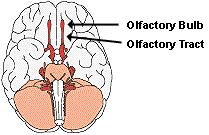| Smelly Research |
| Smelly Research |
| By Ellen Kuwana Neuroscience for Kids Staff Writer May 3, 2000 | ||

|
Stop and Smell the RosesMost of us do not give a second thought to our nostrils, at least not until we catch a cold and can't smell anything. When we have a cold, we do not breathe as well and food may taste bland. Certainly it is difficult to appreciate something like the smell of a rose.
The Left Versus the Right NostrilThe nose is an amazing organ, and now researchers have evidence that smells that enter the left nostril are processed by the brain in a different way than smells that enter the right nostril. In a study published in December 1999, 32 college students were asked to sniff eight common odors through either the right or left nostril and asked to identify each scent and rank each one on pleasantness. One week later, the test was repeated with the other nostril.Researchers found that people were better at identifying odors when they used their left nostrils. However, odors were perceived as more pleasant if smelled through the right nostril. |
Experimental Test Smells
Pineapple |
Right Side/Left SideAlthough the olfactory bulbs on each side are connected, anatomical studies have shown that information from smells entering the left nostril goes predominantly to the left side of the brain, and information from the right nostril goes mainly to the right side of the brain. Areas of the brain that receive information directly from the olfactory bulbs include the amygdala and limbic cortex. These areas of the brain are involved in emotional responses. Signals from the olfactory bulbs also go to the frontal cortex, where identification of odors probably occurs.Researchers believe that the results of the right/left nostril experiments show that the two hemispheres of the brain participate in different aspects of olfactory perception. The right side of the brain may be dominant for emotional processing of this information. This may be why a more emotional response is elicited by smells entering the right nostril. |  Ventral (bottom) surface of the brain |
Did
you
know? |
Humans can distinguish between 3,000 and 10,000 different smells. |
|
References:
|
| BACK TO: | Neuroscience In The News | Table of Contents |
![[email]](./gif/menue.gif) Send E-mail |
![[newsletter]](./gif/menunew.gif) Get Newsletter | ![[search]](./gif/menusea.gif) Search Pages |